2015 MERCEDES-BENZ E-CLASS ESTATE airbag off
[x] Cancel search: airbag offPage 56 of 497

When deployed, the windowbag enhances the
level of protection for the head. However, it
does not protec tthe chest or arms.
In the event of aside impact, the windowbag
is deployed on the side on which the impact
occurs.
If the system determines that they can offer
additional protection to that provided by the
seat belt, awindowbag may be deployed in
other accident situation s(Ypage 53). Deployment of belt tensioners and air-
bags
Important safety notes G
WARNING
After the airbag deploys, the airbag parts are
hot. There is arisk of injury.
Do not touch the airbag parts. Have a
deployed airbag replaced at aqualified spe-
cialist workshop as soon as possible. G
WARNING
Pyrotechnic seat belt tensioners that have
been deployed are no longer operational and
are unable to perform their intended protec-
tive function. This poses an increased risk of
injury or even fatal injury.
Therefore, have pyrotechnic belt tensioners
which have been triggered immediately
replaced at aqualified specialist workshop.
Mercedes-Benz recommends that you have
the vehicle towed to aqualified specialist
workshop after an accident .Take this into
account ,particularly if aseat belt tensioner
was triggered or an airbag was deployed.
An electric motor is used by PRE-SAFE ®
to
trigger the tightening of the seat belt in haz-
ardous situations. This procedure is reversi-
ble.
If the belt tensioners are triggered or an air-
bag is deployed, you will hear abang, and a
small amount of powder may also be released. The
6restraint system warning
lamp lights up.
Only in rare cases will the bang affect your
hearing. In general, the powder released is
not hazardous to health but may cause short- term breathin gdifficulties to persons suffer-
ing from asthma or other pulmonary condi-
tions. Provided it is safe to do so, you should
leave the vehicle immediately or open the
window in order to preven tbreathin gdifficul-
ties.
Operation During the first stage of
acollision, the
restraint system control unit evaluates impor-
tant physical data relating to vehicle deceler- ation or acceleration, such as:
R duration
R direction
R intensity
Based on the evaluation of this data, the
restraint system control unit trigger sthe seat
belt tensioners in the event of ahead-on or
rear collision.
As eat belt tensioner can only be triggered if:
R the ignition is switched on
R the componentsoft he restraint system are
operational; see "Restraint system warning lamp" (Y page 45)
R the belt tongue has engaged in the belt
buckle of the respective fron tseat
The seat belt tensioners in the rear compart-
ment are triggered independently of the lock
status of the seat belts.
If the restraint system control unit detect sa
high severit yofanaccident,incertain head-
on collisions, additional componentsoft he
restraint system are deployed independently
of each another:
R Fron tairbags and driver's kneebag
R Windowbag, if the system determines that
deployment can offer additional protection
to that provided by the seat belt Occupant safety
53Safety Z
Page 57 of 497
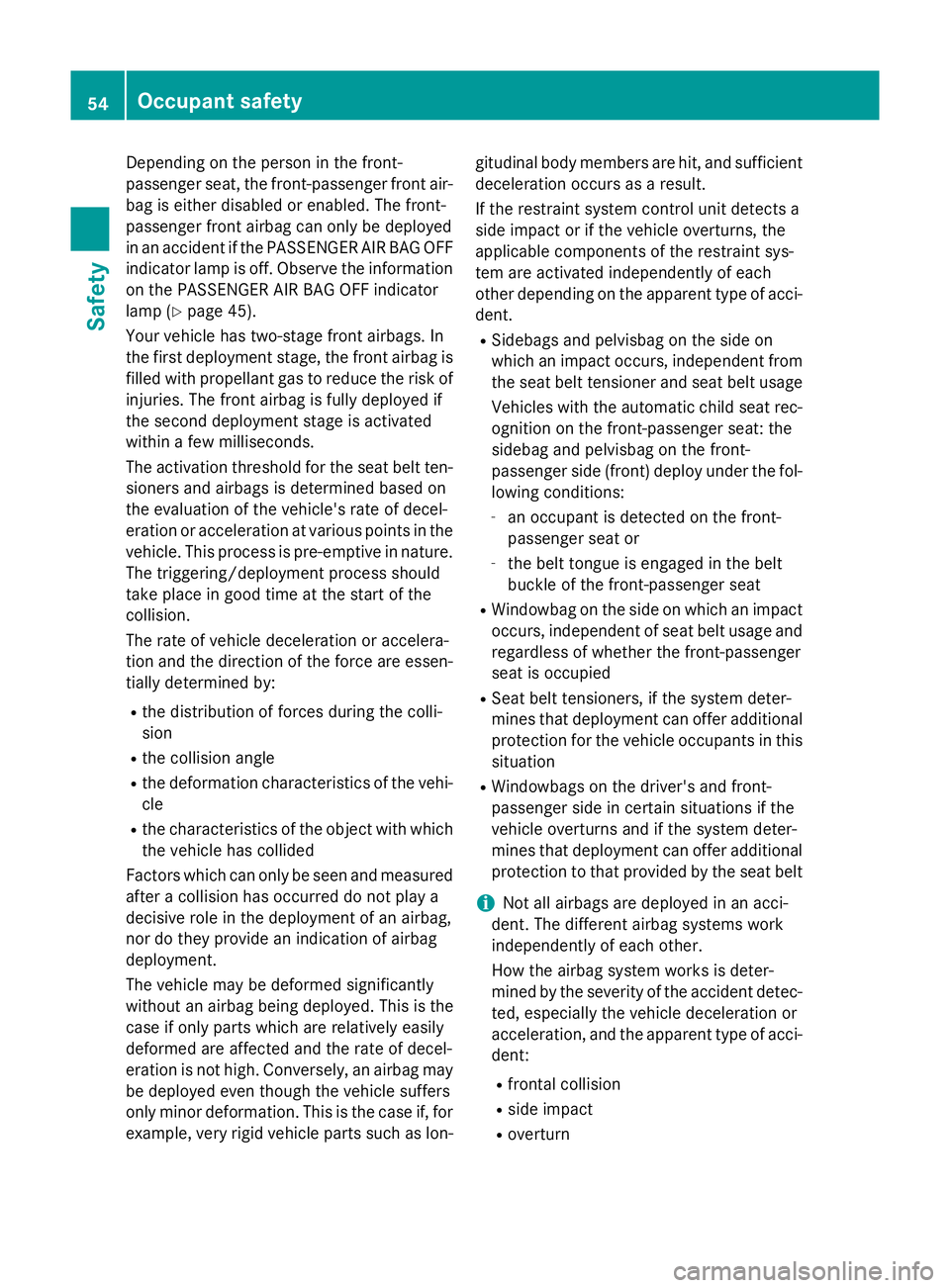
Depending on the perso
ninthe front-
passenge rsea t, the front-passenge rfront air-
ba gise ithe rd isable dorenabled .The front-
passenge rfront airba gcan onl ybedeployed
in an accident if the PASSENGER AIR BAG OFF indicator lamp is off .Obser ve the information
on the PASSENGER AIR BAG OFF indicator
lamp (Y page 45).
Your vehicl ehastwo-stage front airbags. In
the first deployment stage ,the front airba gis
fille dwithp ropellant ga storeduce the risk of
injuries .The front airba gisfullydeployed if
the second deployment stage is activated
withi nafew milliseconds.
Th ea ctivatio nthreshold for the seat belt ten-
sioners and airbags is determine dbased on
the evaluation of the vehicle' srateofd ecel-
eratio noracceleratio natvarious points in the
vehicle. This proces sispre-emptiv einnature.
Th et riggering/deployment proces sshould
take place in good tim eatthe start of the
collision.
Th er ateofv ehicledeceleratio noraccelera-
tio na nd the directio nofthe force ar eessen-
tiall ydetermine dby:
R the distributio nofforces during the colli-
sion
R the collision angle
R the deformatio ncharacteristics of the vehi-
cle
R the characteristics of the object with which
the vehicl ehascollided
Factors which can onl ybeseena nd measured
after acollision ha soccurre ddonot play a
decisiv eroleint he deployment of an airbag,
nor do the yprovide an indicatio nofairbag
deployment.
Th ev ehicl emaybe deformed significantly
without an airba gbeing deployed .Thisist he
cas eifo nlyp arts which ar erelativel yeasily
deformed ar eaffecte dand the rate of decel-
eratio nisn ot high .Conversely ,anairba gm ay
be deployed eve nthoug hthe vehicl esuffers
onl ym inor deformation. This is the cas eif, for
example, ver yrigid vehicl eparts such as lon- gitudina
lbod ym embers ar ehit,a nd sufficient
deceleratio noccurs as aresult.
If the restraint syste mcontro lunitd etects a
side impact or if the vehicl eoverturns, the
applicabl ecomponents of the restraint sys-
tem ar eactivated independentl yofeach
other depending on the apparent typ eofacci-
dent.
R Sidebag sand pelvisba gonthe side on
which an impact occurs, independent from the seat belt tensioner and seat belt usage
Vehicle switht he automatic child seat rec-
ognition on the front-passenge rseat: the
sideba gand pelvisba gonthe front-
passenge rside( front) deploy under the fol-
lowing conditions:
- an occupant is detecte donthe front-
passenge rseator
- the belt tongue is engaged in the belt
buckle of the front-passenge rseat
R Windowbag on the side on which an impact
occurs, independent of seat belt usag eand
regardles sofwhether the front-passenger
seat is occupied
R Sea tbeltt ensioners ,ifthe syste mdeter-
mines tha tdeployme nt can offer additional
protection for the vehicl eoccupants in this
situation
R Windowbag sonthe driver's and front-
passenge rsideinc ertainsituations if the
vehicl eoverturns and if the syste mdeter-
mines tha tdeployme nt can offer additional
protection to tha tprovide dbythe seat belt
i Not al
lairbags ar edeployed in an acci-
dent. Th edifferent airba gsystems work
independentl yofeacho ther.
How the airba gsystemw orks is deter-
mined by the severity of the accident detec- ted ,especially the vehicl edeceleratio nor
acceleration, and the apparent typ eofacci-
dent:
R frontal collision
R side impact
R overturn 54
Occupant safetySafety
Page 62 of 497
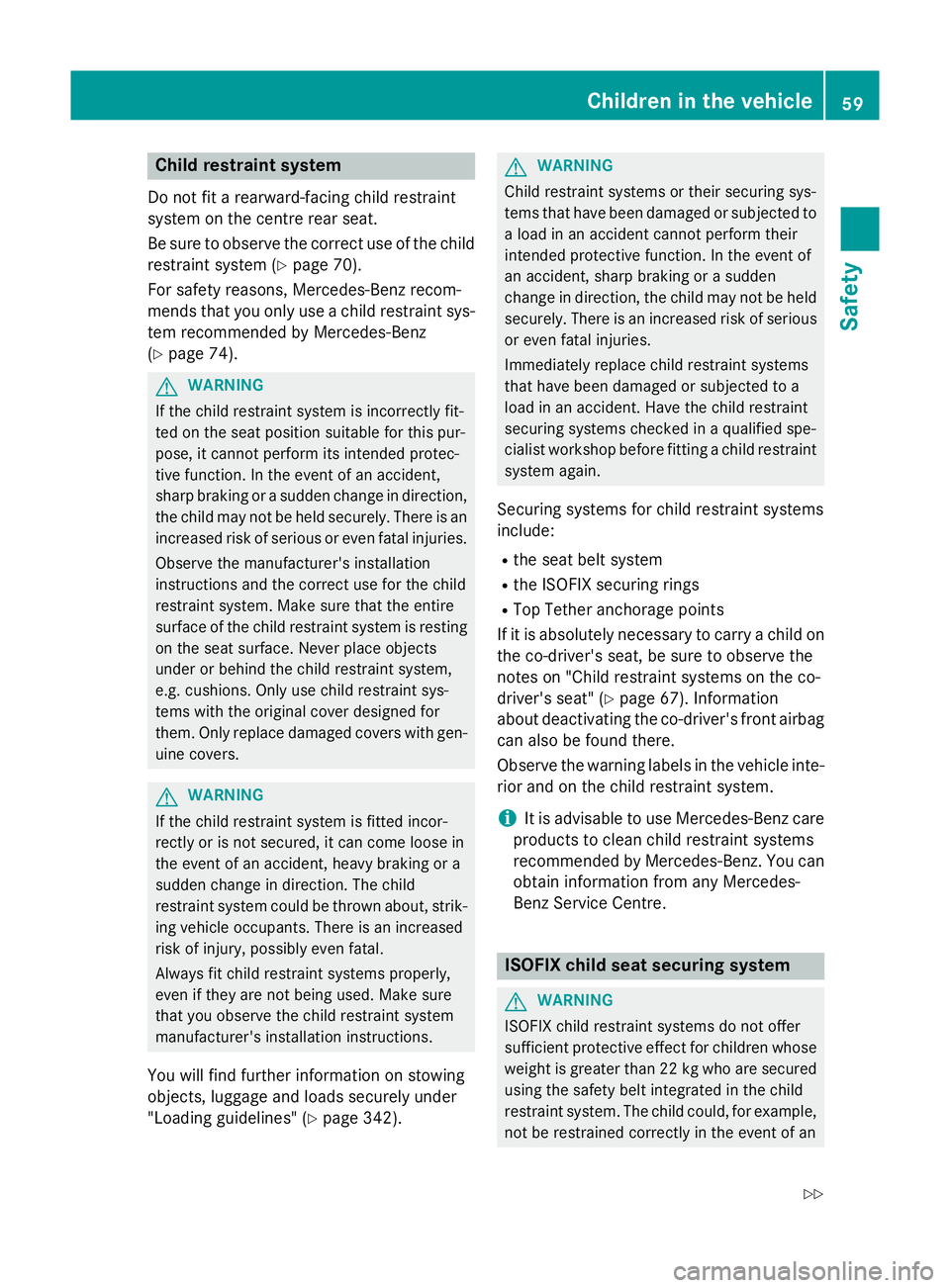
Child restraint system
Do no tfitar earward-facing child restraint
system on th ecentr erear seat.
Be sure to observ ethe correct use of th echild
restraint system (Y page 70).
For safety reasons, Mercedes-Ben zrecom-
mends that you only use achild restraint sys-
te mr ecommended by Mercedes-Benz
(Y page 74). G
WARNING
If th echild restraint system is incorrectly fit-
te dont heseat positio nsuitable for this pur-
pose ,itcanno tperform its intended protec-
tiv ef unction .Intheevent of an accident,
shar pbraking or asudde nchang eind irection,
th ec hild may no tbeheld securely. Ther eisan
increased ris kofserious or eve nfatal injuries.
Observ ethe manufacturer' sinstallation
instruction sand th ecorrec tuse for th echild
restraint system. Mak esure that th eentire
surface of th echild restraint system is resting
on th eseat surface. Never plac eobjects
unde rorb ehindthe child restraint system,
e.g .cushions. Only use child restraint sys-
tems wit hthe original cover designe dfor
them. Only replace damaged covers wit hgen-
uine covers. G
WARNING
If th echild restraint system is fitte dincor-
rectly or is no tsecured, it can com eloos ein
th ee vent of an accident, heav ybraking or a
sudde nchang eind irection .The child
restraint system coul dbethrown about ,strik-
ing vehicle occupants .Ther eisani ncreased
ris kofi njury, possibly eve nfatal.
Always fit child restraint systems properly,
eve nift heya re no tbein gu sed. Mak esure
that you observ ethe child restraint system
manufacturer' sinstallatio ninstructions.
You will fin dfurther informatio nonstowing
objects, luggage and loads securely under
"Loading guidelines" (Y page 342). G
WARNING
Child restraint systems or their securin gsys-
tems that have been damaged or subjected to al oad in an acciden tcanno tperform their
intended protective function .Intheevent of
an accident, shar pbraking or asudden
chang eindirection ,the child may no tbeheld
securely. Ther eisanincreased ris kofserious
or eve nfatal injuries.
Immediately replace child restraint systems
that have been damaged or subjected to a
load in an accident. Hav ethe child restraint
securin gsystems checked in aqualified spe-
cialist worksho pbefore fittin gachild restraint
system again.
Securin gsystems for child restraint systems
include:
R thes eat belt system
R theI SOFI Xsecurin grings
R Top Tether anchorage points
If it is absolutely necessary to carry achild on
th ec o-driver's seat ,besure to observ ethe
note son" Child restraint systems on th eco-
driver' sseat "(Ypage 67). Information
about deactivatin gthe co-driver's fron tairbag
can also be foun dthere.
Observ ethe warning labels in th evehicle inte-
rior and on th echild restraint system.
i It is advisable to use Mercedes-Ben
zcare
product stoclean child restraint systems
recommended by Mercedes-Benz. You can obtain informatio nfroma ny Mercedes-
Ben zServic eCentre. ISOFIX child seat securing system
G
WARNING
ISOFIX child restraint systems do no toffer
sufficient protective effect for childre nwhose
weigh tisgreate rtha n2 2k gw ho are secured
usin gthe safety belt integrate dinthechild
restraint system. The child could, for example, no tber estraine dcorrectly in th eevent of an Children in th
evehicle
59Safety
Z
Page 69 of 497
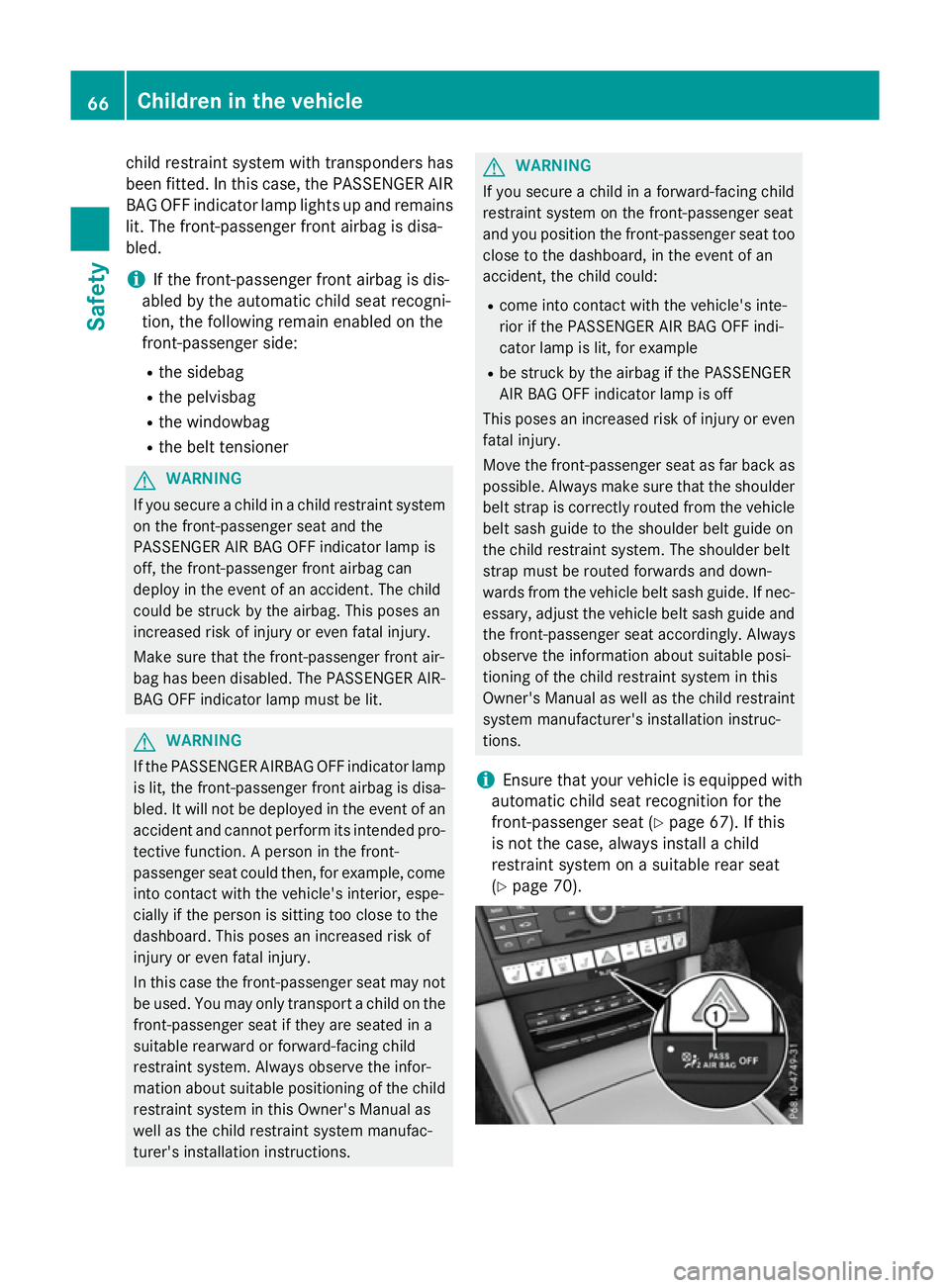
chil
drestraint system with transponders has
bee nfitted .Inthis case, the PASSENGER AIR
BAG OFF indicator lamp lights up and remains
lit. The front-passenger front airba gisdisa-
bled.
i If the front-passenger front airba gisdis-
able dbyt he automatic chil dseatrecogni-
tion, the following remain enabled on the
front-passenger side:
R the sidebag
R the pelvisbag
R the windowbag
R the bel ttensioner G
WARNING
If yo usecure achildinac hildr estraint system
on the front-passenger sea tand the
PASSENGER AIR BAG OFF indicator lamp is
off, the front-passenger front airba gcan
deploy in the event of an accident. The child
could be struck by the airbag. Thi sposes an
increased ris kofinjury or eve nfata linjury.
Make sure that the front-passenger front air-
ba gh asbee ndisable d. The PASSENGER AIR-
BAG OFF indicator lamp mus tbelit. G
WARNING
If the PASSENGER AIRBAG OFF indicator lamp is lit, the front-passenger front airba gisdisa-
bled. It will not be deployed in the event of an
accident and cannot perform its intended pro-
tectiv efunction. Aperson in the front-
passenger sea tcould then, for example, come
into contact with the vehicle's interior ,espe-
ciall yift he person is sitting too clos etothe
dashboard. Thi sposes an increased ris kof
injury or eve nfata linjury.
In this cas ethe front-passenger sea tmay not
be used. You may only transpor tachildont he
front-passenger sea tifthey are seated in a
suitabl erearward or forward-facing child
restraint system. Alway sobserve the infor-
mation abou tsuitabl epositioning of the child
restraint system in this Owner's Manua las
well as the chil drestraint system manufac-
turer's installation instructions. G
WARNING
If yo usecure achildinaf orward-facing child
restraint system on the front-passenger seat
and yo uposition the front-passenger sea ttoo
close to the dashboard, in the event of an
accident, the chil dcould:
R come into contact with the vehicle's inte-
rio rift he PASSENGER AIR BAG OFF indi-
cator lamp is lit, for example
R be struck by the airba gifthe PASSENGER
AIR BAG OFF indicator lamp is off
Thi sposes an increased ris kofinjury or even
fata linjury.
Move the front-passenger sea tasfar back as
possible .Alway smake sure that the shoulder
bel tstra pisc orrectly routed from the vehicle
bel tsashg uide to the shoulder bel tguide on
the chil drestraint system. The shoulder belt
stra pmustb erouted forward sand down-
wards from the vehicle bel tsashg uide .Ifnec-
essary ,adjust the vehicle bel tsashg uide and
the front-passenger sea taccordingly .Always
observe the information abou tsuitabl eposi-
tioning of the chil drestraint system in this
Owner's Manua laswellast he chil drestraint
system manufacturer' sinstallation instruc-
tions.
i Ensur
ethat your vehicle is equipped with
automatic chil dseatrecognition for the
front-passenger sea t(Ypage 67). If this
is not the case, always install achild
restraint system on asuitabl erears eat
(Y page 70). 66
Childre
ninthe vehicleSafety
Page 70 of 497
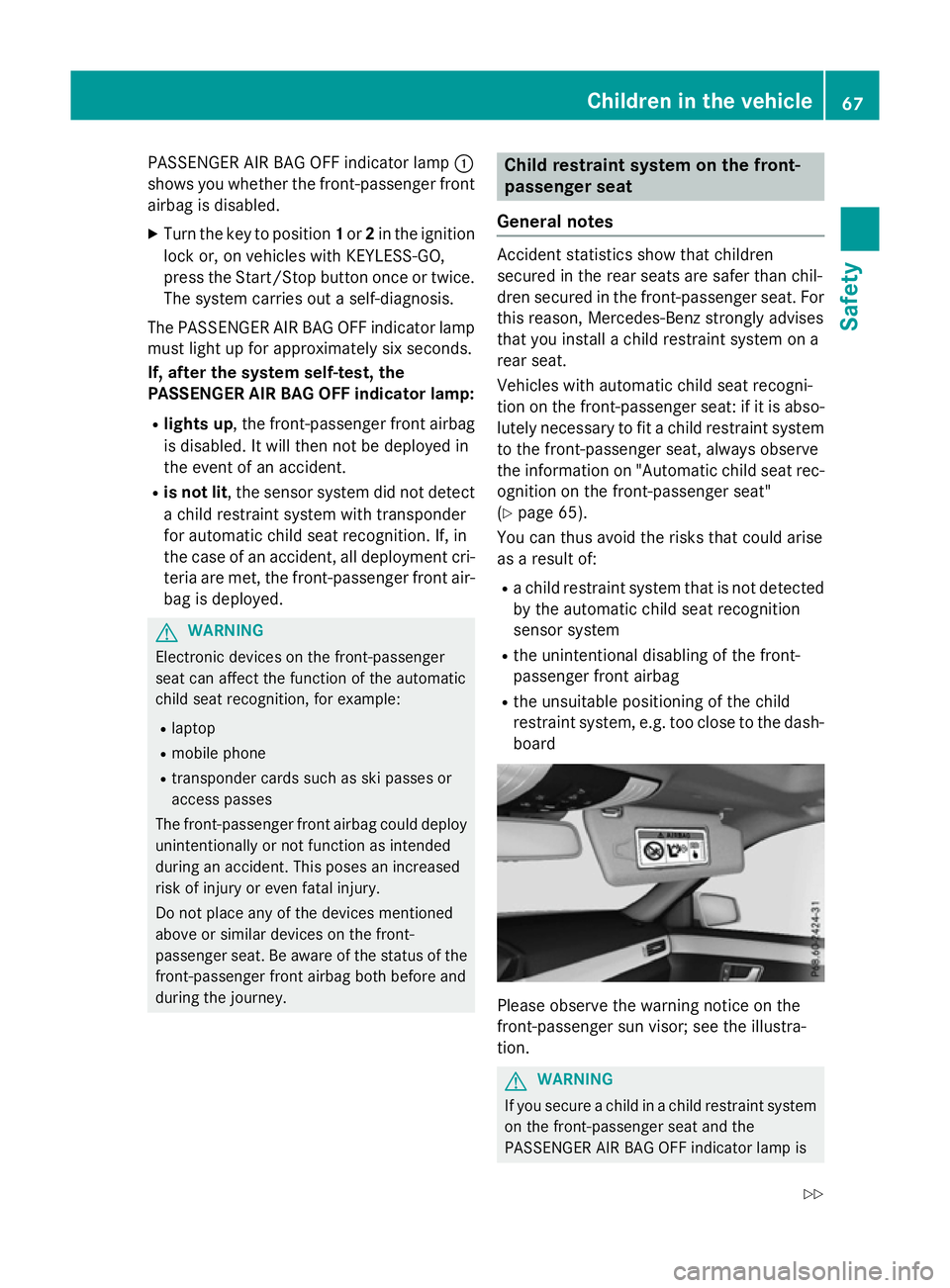
PASSENGERA
IR BAG OFF indicator lamp :
shows you whether the front-passenger front airbag is disabled.
X Turn the key to position 1or 2in the ignition
lock or, on vehicles with KEYLESS-GO,
press the Start/Stop button once or twice. The system carries out aself-diagnosis.
The PASSENGERA IR BAG OFF indicator lamp
must light up for approximately six seconds.
If, after the system self-test, the
PASSENGER AIR BAG OFF indicator lamp:
R lights up ,the front-passenger fronta irbag
is disabled. It will then not be deployed in
the event of an accident.
R is not lit,t he sensor system did not detect
ac hild restraint system with transponder
for automatic child seat recognition. If, in
the case of an accident ,all deployment cri-
teria are met, the front-passenger fronta ir-
bag is deployed. G
WARNING
Electronic devices on the front-passenger
seat can affect the function of the automatic
child seat recognition, for example:
R laptop
R mobile phone
R transponder cards such as ski passes or
access passes
The front-passenger fronta irbag could deploy
unintentionally or not function as intended
during an accident .This poses an increased
risk of injury or even fatal injury.
Do not place any of the devices mentioned
above or similar devices on the front-
passenger seat. Be aware of the status of the front-passenger fronta irbag both before and
during the journey. Child restraint system on the front-
passenger seat
General notes Accident statistics show that children
secured in the rear seats are safer than chil-
dren secured in the front-passenger seat. For
this reason, Mercedes-Benz strongly advises
that you install achild restraint system on a
rear seat.
Vehicles with automatic child seat recogni-
tion on the front-passenger seat: if it is abso- lutely necessary to fit achild restraint system
to the front-passenger seat, alway sobserve
the information on "Automatic child seat rec-
ognition on the front-passenger seat"
(Y page 65).
You can thus avoid the risks that could arise
as aresult of:
R ac hild restraint system that is not detected
by the automatic child seat recognition
sensor system
R the unintentional disabling of the front-
passenger fronta irbag
R the unsuitable positionin gofthe child
restraint system, e.g. too close to the dash-
board Please observe the warning notice on the
front-passenger sun visor; see the illustra-
tion.
G
WARNING
If you secure achild in achild restraint system
on the front-passenger seat and the
PASSENGER AIR BAG OFF indicator lamp is Children in the vehicle
67Safety
Z
Page 71 of 497
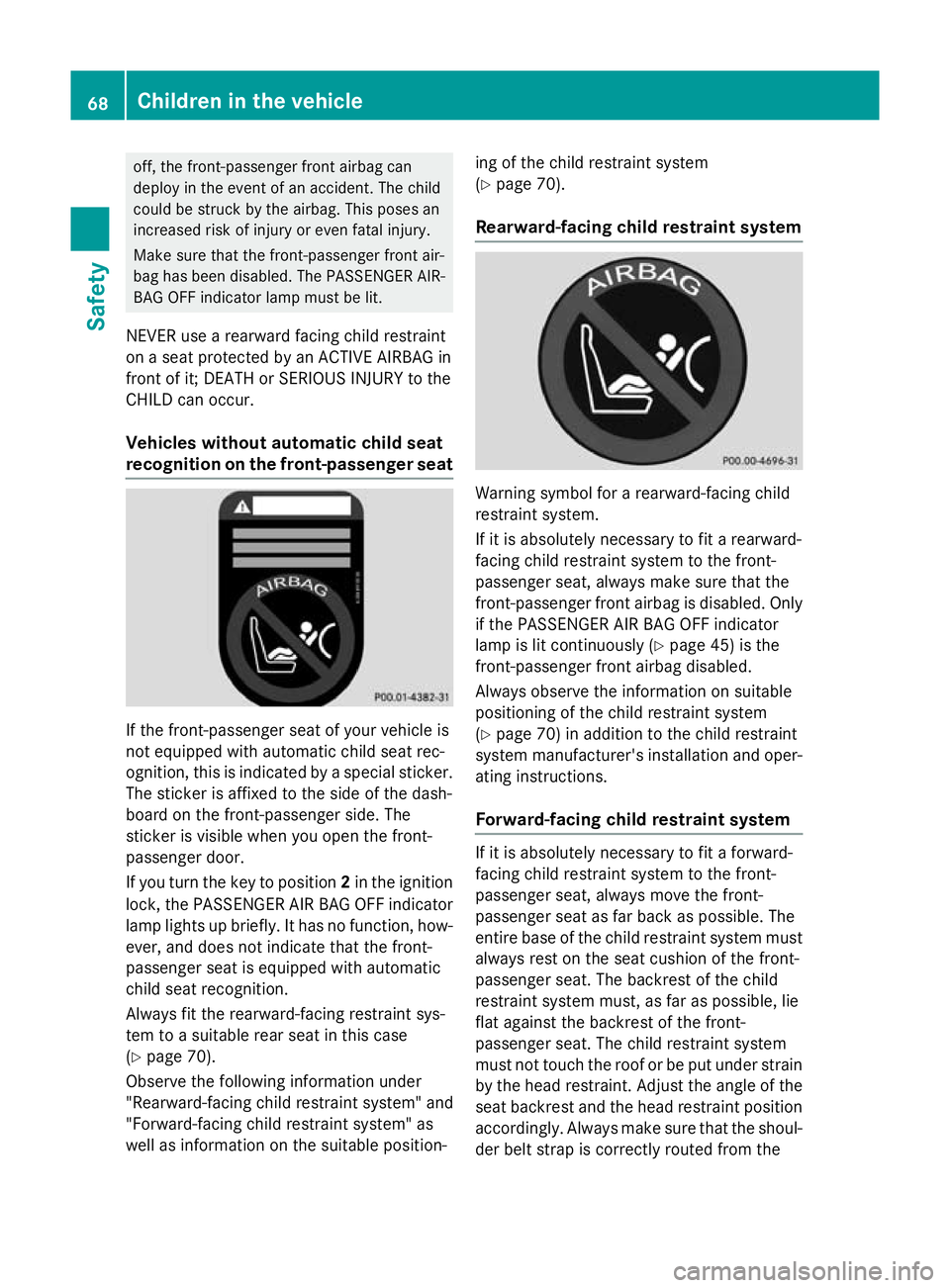
off, the front-passenger front airbag can
deploy in the event of an accident .The child
could be struck by the airbag. This poses an
increased risk of injury or even fatal injury.
Make sure that the front-passenger front air-
bag has been disabled. The PASSENGER AIR- BAG OFF indicator lamp must be lit.
NEVERu searearward facing child restraint
on aseat protected by an ACTIVE AIRBAGin
front of it; DEATH or SERIOUS INJURY to the
CHILD can occur.
Vehicles without automatic child seat
recognition on the front-passenger seat If the front-passenger seat of your vehicle is
not equipped with automatic child seat rec-
ognition
,this is indicated by aspecial sticker.
The sticker is affixed to the side of the dash-
board on the front-passenger side. The
sticker is visible when you open the front-
passenger door.
If you turn the key to position 2in the ignition
lock, the PASSENGER AIR BAG OFF indicator lamp lights up briefly. It has no function, how-ever, and does not indicate that the front-
passenger seat is equipped with automatic
child seat recognition.
Always fit the rearward-facing restraint sys-
tem to asuitable rear seat in this case
(Y page 70).
Observe the following information under
"Rearward-facing child restraint system" and
"Forward-facing child restraint system" as
well as information on the suitable position- ing of the child restraint system
(Y
page 70).
Rearward-facing child restraint system Warning symbol for
arearward-facing child
restraint system.
If it is absolutely necessary to fit arearward-
facing child restraint system to the front-
passenger seat, always make sure that the
front-passenger front airbag is disabled. Only if the PASSENGER AIR BAG OFF indicator
lamp is lit continuously (Y page 45) is the
front-passenger front airbag disabled.
Always observe the information on suitable
positioning of the child restraint system
(Y page 70) in addition to the child restraint
system manufacturer' sinstallation and oper-
ating instructions.
Forward-facing child restraint system If it is absolutely necessary to fit
aforward-
facing child restraint system to the front-
passenger seat, always move the front-
passenger seat as far back as possible. The
entire base of the child restraint system must
always rest on the seat cushion of the front-
passenger seat. The backrest of the child
restraint system must, as far as possible, lie
flat against the backrest of the front-
passenger seat. The child restraint system
must not touch the roof or be put under strain by the head restraint .Adjust the angle of the
seat backrest and the head restraint position accordingly. Always make sure that the shoul-
der belt strap is correctly routed from the 68
Children in the vehicleSafety
Page 73 of 497
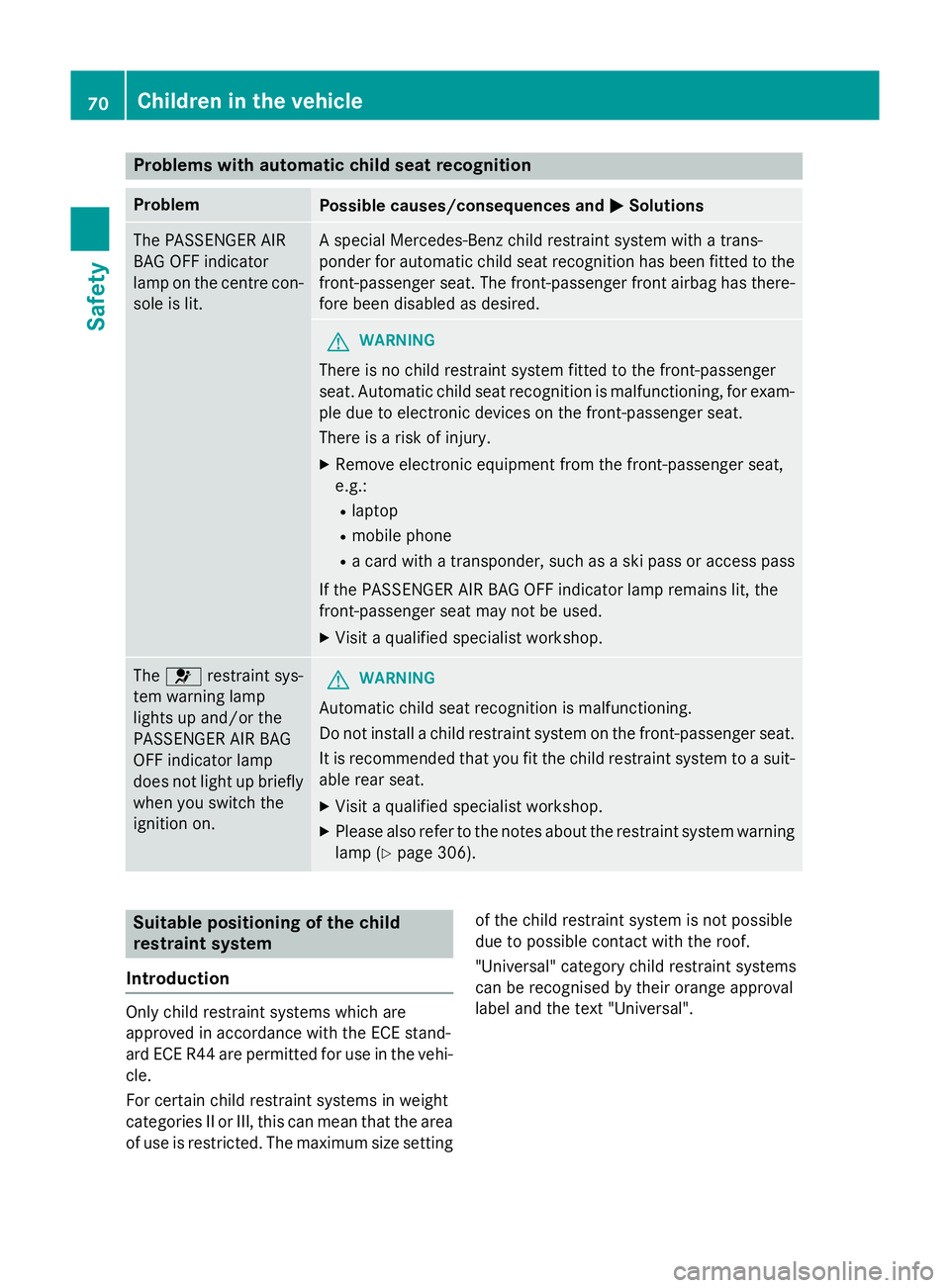
Problems with automatic child seat recognition
Problem
Possible causes/consequences and
M
MSolutions The PASSENGER AIR
BAG OFF indicator
lamp on the centre con-
sole is lit. As
pecial Mercedes-Benz child restraint system with atrans-
ponder for automatic child seat recognition has been fitted to the
front-passenger seat. The front-passenger front airbag has there- fore been disabledasd esired. G
WARNING
There is no child restraint system fitted to the front-passenger
seat. Automatic child seat recognition is malfunctioning, for exam-
ple due to electronic devices on the front-passenger seat.
There is arisk of injury.
X Remove electronic equipment from the front-passenger seat,
e.g.:
R laptop
R mobile phone
R ac ard with atransponder, such as aski pass or access pass
If the PASSENGER AIR BAG OFF indicator lamp remains lit, the
front-passenger seat may not be used.
X Visit aqualified specialist workshop. The
6 restraint sys-
tem warning lamp
lights up and/or the
PASSENGER AIR BAG
OFF indicator lamp
does not light up briefly
when you switch the
ignition on. G
WARNING
Automatic child seat recognition is malfunctioning.
Do not install achild restraint system on the front-passenger seat.
It is recommended that you fit the child restraint system to asuit-
able rear seat.
X Visit aqualified specialist workshop.
X Please also refer to the notes about the restraint system warning
lamp (Y page 306). Suitable positioning of the child
restraint system
Introduction Only child restraint systems which are
approved in accordance with the ECE stand-
ard ECE R44 are permitted for use in the vehi- cle.
For certain child restraint systems in weight
categories II or III, this can mean that the area of use is restricted. The maximum size setting of the child restraint system is not possible
due to possible contact with the roof.
"Universal" category child restraint systems
can be recognised by their orange approval
label and the text "Universal".70
Children in the vehicleSafety
Page 75 of 497

Suitability of the seats for attaching belt-secured child restraint systems
If you use
ababy car seat of category 0or0+orarearward-facing child restraint system of
category Ionarear seat, you must adjust the driver's or front-passenger seat so that the seat
does not touch the child restraint system.
If you use acategory I, forward-facing child restraint system, you should remove the head
restraint of the respective seat (Y page 127), if possible. The backrest of the child restraint
system must, as far as possible, lie flat against the backrest of the seat.
Always observe the notes in the "Childr estraint system" section (Ypage 59) and the child
restraint system manufacturer's installation instructions.
When you remove the child restraint system you must replace the head restraint sagain
immediately. All vehicle occupants must adjust their head restraint scorrectly before begin-
ning the journey (Y page 125).
Legend for the table:
XS eat which is unsuitable for children in this weight category.
US uitable for child restraint systems in th e"Universal" categor ytha tare approve dfor use in
this weigh tcategory.
LS uitable for child restraint systems as recommended, see th etable "Recommended child
restraint systems "(Ypage 74). Suitable for semi-universal child restraint systems if the
vehicl eand th eseat are listed in th echild restraint system manufacturer' svehicl emodel
list. Weight category Front-passenger seat Rea
rseat Front-
passenger
front airbag activated Th
ef ront-
passenger
front airbag is disabled Left
,right Centre
1 0
up to 10 kg X X U U
0+
up to 13 kg X
L
2 U U
I
9kgupt
o18kg L L U U
II
15 kg up to 25 kg U, L L U U
III
22 kg up to 36 kg U, L L U U
i
Vehicles wit
hafoldin gbench seat in th eload compartmen t(Estate): information on child
restraint systems on th efoldin gbench seat can be obtaine datany Mercedes-Ben zService
Centre.
1 Child restrain tsystems wit hasupporting bracke tare no tsuitable for this seat.
2 Vehicles wit hautomatic child seat recognition in th efront-pa ssenger seat :achild restrain tsystem of the
"Universal" categor ywithat ransponder for automatic child seat recognition mus tbefitted. The PASSENGER
AIRBA GOFFindicator lamp in th ecentr econsol emustbel it. 72
Children in th
evehicleSafety